Are you a traveler whose journey is often guided by the next delicious meal? You’ve found a kindred spirit! Some of the most vivid and joyful memories from my travels are intrinsically linked to the food I’ve experienced. I’ve explored bustling markets, learned to cook local dishes, and savored flavors that tell stories of a place. That’s precisely why Vietnam, and specifically the ancient town of Hoi An, was high on my list – to taste its legendary cuisine right at the source. Embarking on a Hoian Food Tour felt like the ultimate way to dive deep.
Having enjoyed the vibrant, fresh flavors of Vietnamese cuisine in restaurants back home, I was eager to experience the authentic versions. Dishes like light vermicelli salads with zesty dressings, rich bowls of beef pho fragrant with spices, and delicate spring rolls packed with herbs and fresh ingredients have always captivated my palate. Hoi An, nestled in central Vietnam, is renowned for its unique culinary identity, blending influences from the north and south, making it the ideal destination for a dedicated exploration of the local food scene. A Hoian Food Tour promised an intimate look into this delicious world.
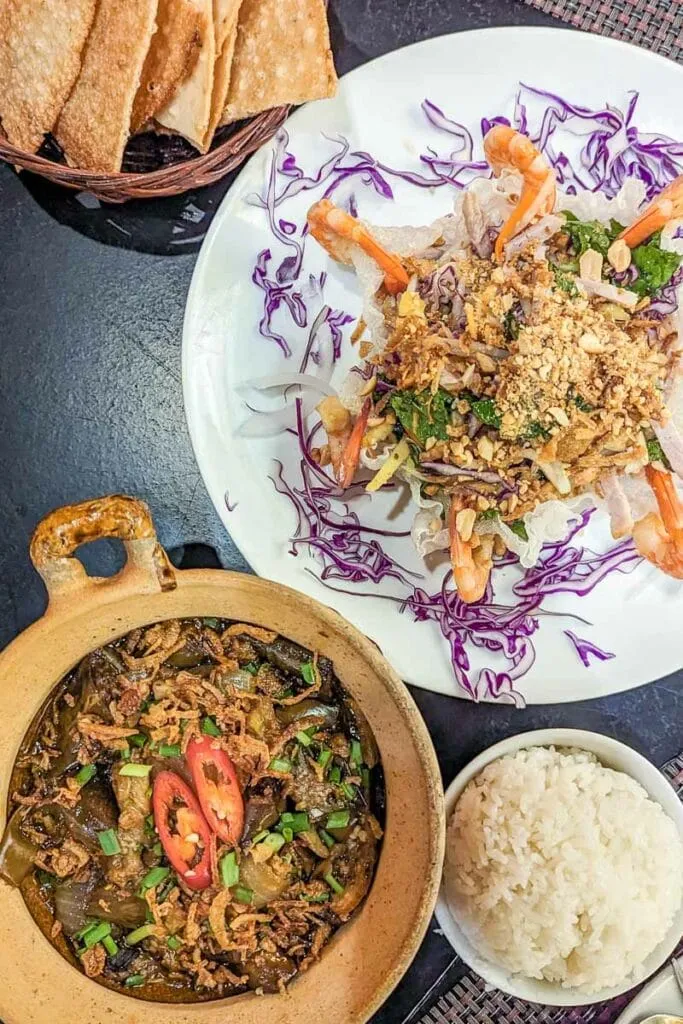 Food scene in Hoi An with various dishes
Food scene in Hoi An with various dishes
Choosing the right Hoian Food Tour is key. We opted for a well-regarded street food tour that promised seven stops over three hours. What drew me in was the mix of experiences – some stops at unassuming street stalls only a local would know, and others in more established eateries. The idea was to get a real taste of how people in Hoi An eat every day, guided by someone with deep knowledge of the city’s culinary secrets. This approach significantly enhances the Hoian Food Tour experience.
Why Take a Hoian Food Tour?
Hoi An is more than just picturesque lanterns and ancient architecture; it’s a culinary melting pot with dishes unique to the area. Its history as a bustling trading port exposed it to influences from Chinese, Japanese, and later, European cuisines, particularly French. This heritage, combined with the availability of fresh local ingredients and unique natural resources (like the special well water for Cao Lầu noodles), has created a distinct food culture. A Hoian Food Tour cuts through the noise, leading you directly to authentic flavors and the stories behind them.
Discover the Best – Where to Go on Vacation in Florida
Your Ultimate Guide – what to eat in destin florida
Discover Fun Things to Do in LA Today
Navigating the street food scene alone can be intimidating. Where are the best, most hygienic stalls? What are they even selling? How do you order? A Hoian Food Tour with a local guide solves all these problems. Our guide, Hahn, was not only knowledgeable about the food but also shared insights into local life, adding layers to the experience beyond just eating. It transforms a simple meal into a cultural lesson.
My Experience: A Stop-by-Stop Hoian Food Tour
Our culinary adventure began at a comfortable cafe, providing a relaxed setting to meet our guide and fellow food enthusiasts. Our small group included travelers from different parts of the world, including one lady from Chicago. It was a pleasant start, sharing travel stories before diving into the delicious journey ahead. This intimate group setting often makes a Hoian Food Tour more enjoyable and interactive.
Stop 1: Vietnamese Coffee Culture
Vietnam’s coffee is legendary, and rightfully so. The traditional drip method produces a strong, bold brew. The most common way to enjoy it is cà phê sữa đá – iced coffee with sweet condensed milk. This practice dates back to the 1850s when fresh milk was scarce. The condensed milk perfectly balances the coffee’s bitterness, creating a rich, caramelly flavor. It’s a quintessential part of any Hoian Food Tour.
Beyond the classic, Vietnamese coffee culture has evolved. We sampled iced coconut coffee, a creamy, tropical delight, and learned about other variations like sea salt coffee and egg coffee. While feeling more like dessert than a morning pick-me-up, these unique drinks showcase the creativity within Vietnam’s coffee scene. Experiencing this variety adds a sweet note to the Hoian Food Tour.
 Vietnamese coconut coffee with ice
Vietnamese coconut coffee with ice
Stop 2: Hidden Street Food Snacks
Leaving the cafe, our guide led us through Hoi An’s charming streets, alive with daily activity. We paused at a humble street stall that, to an untrained eye, might seem unremarkable. This is where the value of a Hoian Food Tour truly shines – discovering hidden gems you’d never find independently. The vendor, a local lady, expertly prepared small, tempting bites.
We tried a selection of dumplings: bánh lọc, translucent tapioca dumplings filled with shrimp; bánh ít, sticky rice cakes with a mushroom filling steamed in banana leaves; and dumplings with a savory mung bean filling. Served with a flavorful fish sauce dressing, these were delightful, savory snacks. Our guide explained these are common afternoon treats, part of the local rhythm of life in Hoi An. Observing locals stop by for a quick plate provided a genuine glimpse into the city’s culture during our Hoian Food Tour.
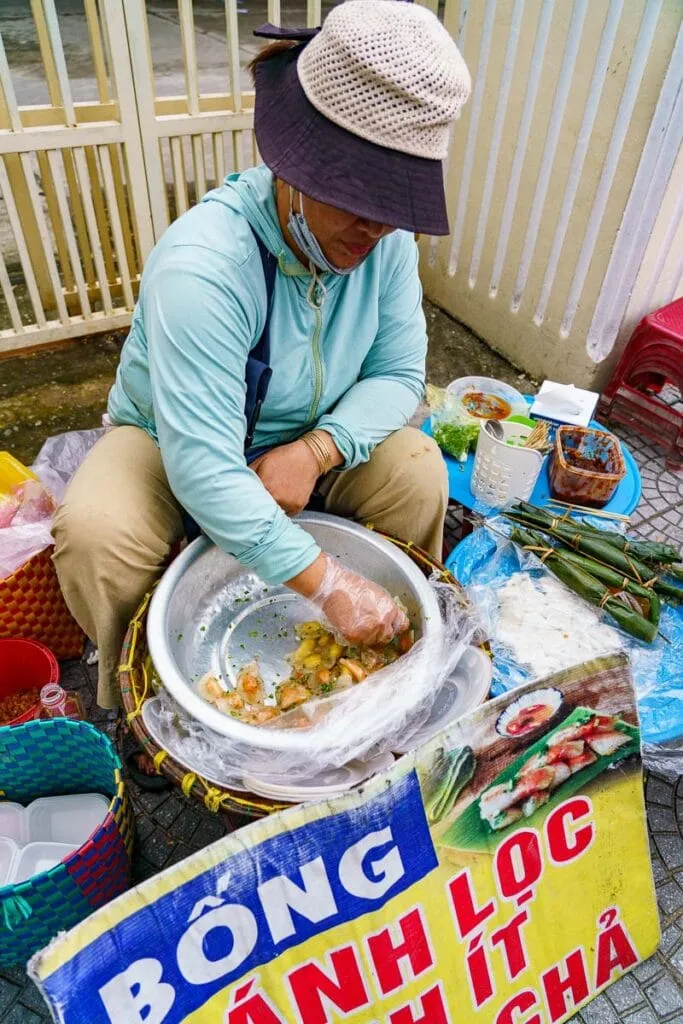 Hoi An street food vendor preparing dumplings
Hoi An street food vendor preparing dumplings
Stop 3: Hoi An’s Noodle Icons – Mì Quảng and Cao Lầu
Our third stop was at a casual eatery where large vats of broth simmered, hinting at the deliciousness within. Again, this was a place where a guide was invaluable, bridging the gap between curious tourist and authentic local experience. Here, we were introduced to two dishes synonymous with Hoi An: Mì Quảng and Cao Lầu. No Hoian Food Tour would be complete without them.
Mì Quảng features wide, flat yellow rice noodles served with a concentrated, flavorful broth (not a full bowl like pho). Toppings include slices of pork, fresh greens, bean sprouts, and crunchy rice crackers. The broth was incredibly aromatic and comforting. We customized our bowls with lime and chili, adding personal touches to this local favorite.
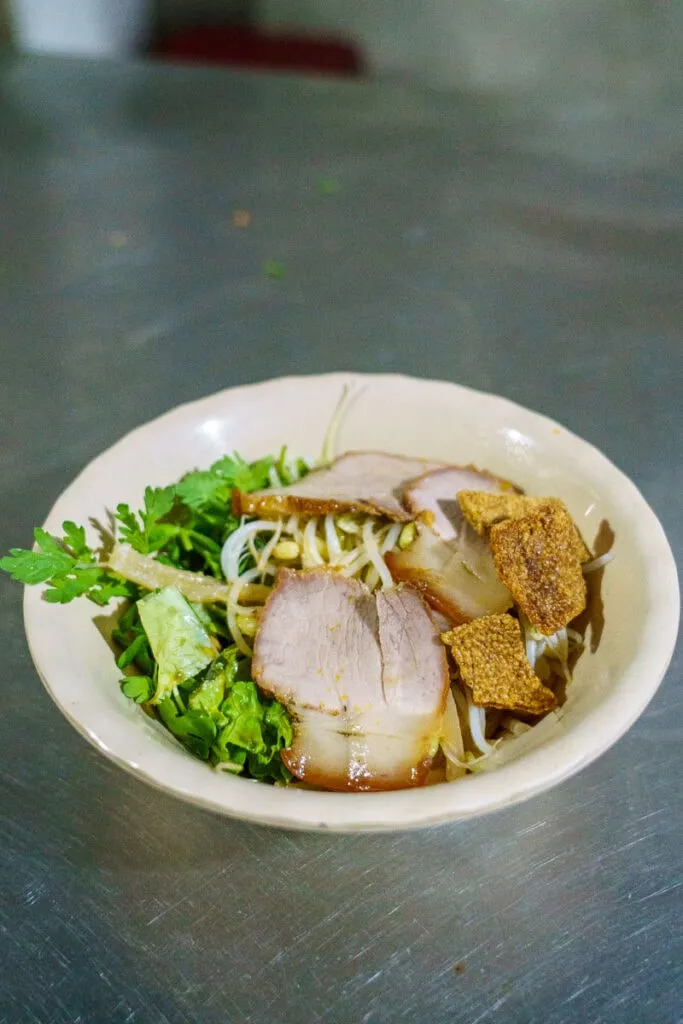 Bowl of Mi Quang noodles
Bowl of Mi Quang noodles
Cao Lầu is another unique Hoi An noodle dish. Similar in presentation to Mì Quảng with pork and herbs, its distinctiveness comes from the noodles themselves. Legend has it that the water used for Cao Lầu noodles must be sourced from a specific ancient well within Hoi An, and the ashes mixed with the dough must come from local trees. This unique process gives the noodles a yellowish tint, a smoky flavor, and a satisfyingly chewy texture found nowhere else. Trying these dishes side-by-side highlighted the regional specificity that makes a Hoian Food Tour so special.
Trying the unique Cao Lau noodles, a highlight of any Hoian Food Tour.
Stop 4: Com Ga – The Simple Pleasure of Chicken Rice
Next on our Hoian Food Tour was Cơm Gà, or Vietnamese chicken rice. This stop was another vibrant street-side setup on a busy Hoi An street, showing how integrated food stalls are into the city’s fabric. The vendor specialized in this one comforting dish, a testament to focusing on doing one thing exceptionally well.
The foundation of Cơm Gà is fragrant turmeric rice, cooked in chicken stock for extra depth of flavor. It’s topped with shredded chicken mixed into a refreshing salad with onion, carrot, green papaya, and Vietnamese coriander, all brought together by a tangy dressing. Served with a side of rich chicken soup and optional chili, it’s a simple yet incredibly satisfying meal. Sitting on low stools, surrounded by the buzz of daily life, made this stop a true cultural immersion during the Hoian Food Tour.
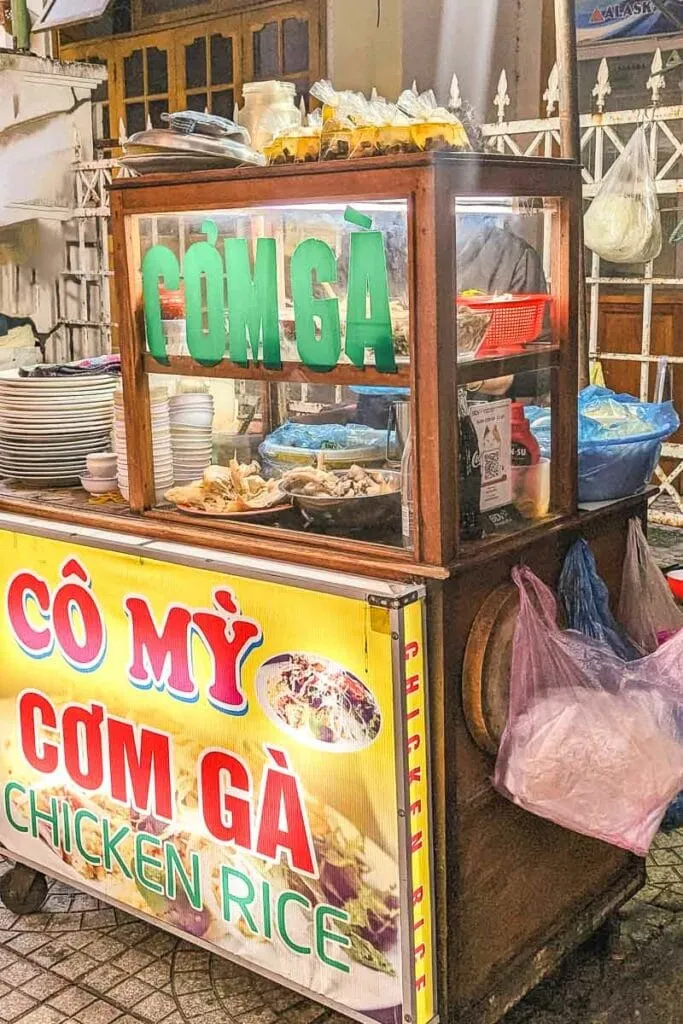 Stall selling chicken rice in Hoi An
Stall selling chicken rice in Hoi An
Stop 5: The Legendary Banh Mi
No visit to Vietnam, and certainly no Hoian Food Tour, is complete without trying a Banh Mi. This iconic sandwich, a delicious legacy of French colonial influence, is a staple across the country, but Hoi An is famous for its versions. We visited a particularly popular spot, known locally as the “Banh Mi Queen,” which bustled with both locals and tourists.
A classic Banh Mi features a light, crusty baguette filled with an array of ingredients: pâté, various cold cuts (often pork-based), pickled vegetables (daikon and carrot), mayonnaise, fresh cilantro, and a savory liquid seasoning. The combination creates a symphony of textures and flavors – crusty, soft, savory, tangy, fresh. Despite having tried underwhelming versions elsewhere, the one on the Hoian Food Tour was fresh, flavorful, and generously filled.
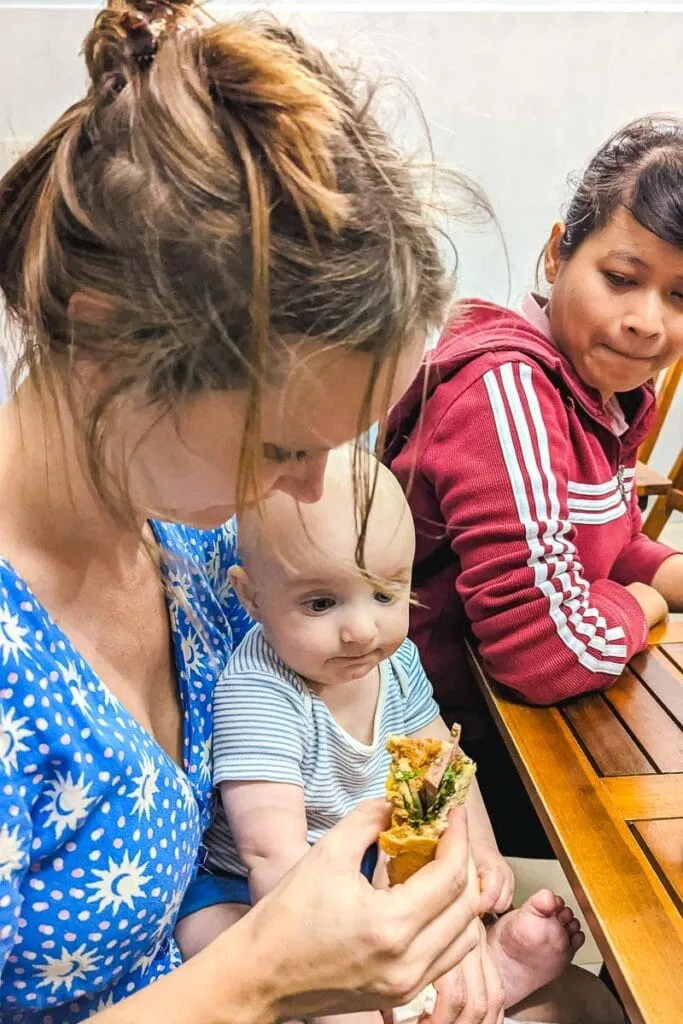 Banh Mi sandwich being held
Banh Mi sandwich being held
What’s remarkable about Banh Mi, especially in places like Hoi An, is the incredible value. These substantial sandwiches cost less than a dollar, offering a filling and tasty meal that’s perfect for travelers on a budget or just needing a quick bite. Experiencing the energy of a famous Banh Mi shop adds another layer to the Hoian Food Tour experience.
Stop 6: Bún Thịt Nướng – Freshness in a Bowl
Even as we were getting full, the culinary discoveries continued. Bún Thịt Nướng is a dish I had already fallen in love with earlier in my trip, and I was excited to try another rendition on the Hoian Food Tour. It’s essentially a Vietnamese noodle salad, a refreshing contrast to the richer noodle soups.
This dish consists of delicate vermicelli rice noodles topped with succulent grilled pork, fresh herbs (like mint, basil, and the distinctive perilla or rice paddy herb), shredded vegetables (often lettuce and cucumber), and crunchy peanuts. The magic lies in the dressing – a vibrant mix of fish sauce, lime juice, sugar, and chili. Pouring this dressing over the ingredients brings everything together into a harmonious, fresh, and flavorful bowl. Our guide pointed out the perilla herb, explaining its unique aromatic contribution, deepening our appreciation for the ingredients encountered on the Hoian Food Tour.
Stop 7: Bánh Xèo – The Sizzling Pancake
Our Hoian Food Tour concluded at a popular restaurant in the ancient town, where we were presented with a sharing plate of Bánh Xèo. These “sizzling pancakes” are bright yellow, made from rice flour and turmeric, and folded over a filling typically including shrimp and bean sprouts. The name “Bánh Xèo” comes from the sizzling sound the batter makes when it hits the hot pan.
While I’d seen Bánh Xèo before, I hadn’t learned the traditional way to eat them. This is where having a guide on a Hoian Food Tour is invaluable. The ritual involves taking a piece of rice paper, adding a section of the crispy pancake, loading it with fresh greens (lettuce, herbs, cucumber), rolling it tightly like a spring roll, and dipping it into either a sweet fish sauce or a rich peanut sauce. The combination of crispy pancake, fresh herbs, and savory dipping sauce is a delightful textural and flavor experience – a perfect grand finale for our Hoian Food Tour.
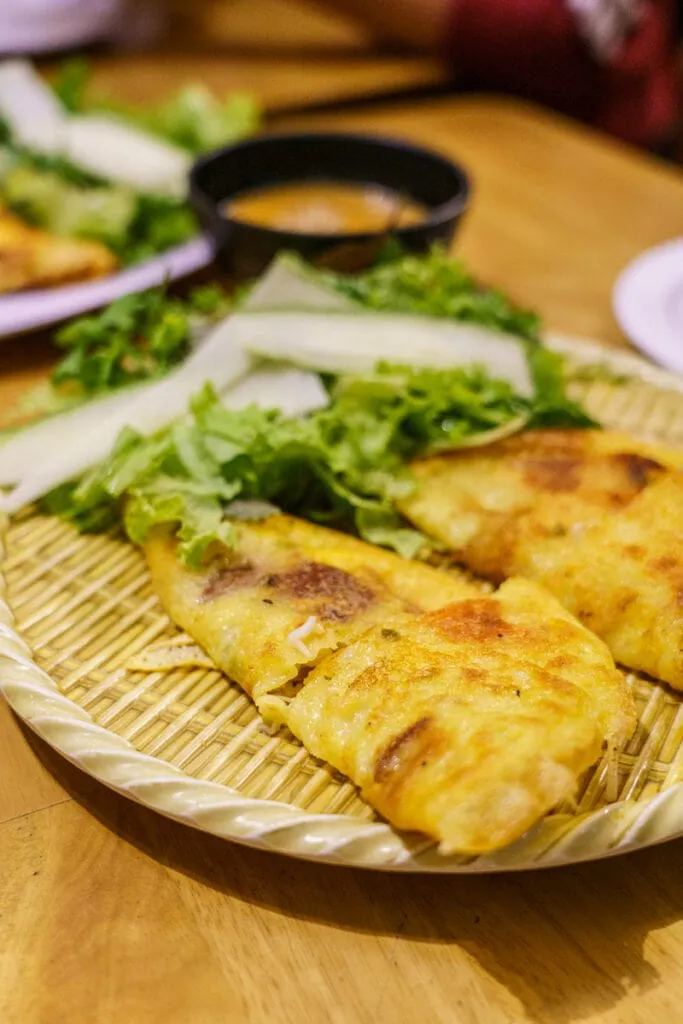 Vietnamese Banh Xeo pancake
Vietnamese Banh Xeo pancake
As a parting gift, our guide gave us some local coconut pastries, a sweet end to a fantastic journey. The Hoian Food Tour was an incredible way to not only taste a variety of dishes but also gain confidence in trying new things and understand the cultural context of Vietnamese cuisine. It provided inspiration for further culinary exploration during the rest of our time in Vietnam.
Soaking in the atmosphere of Hoi An after a wonderful food tour.
Tips for Your Hoian Food Tour
- Dietary Requirements: Vietnamese cuisine heavily relies on fish sauce. If you have dietary restrictions (vegetarian, vegan, allergies), communicate this clearly to the tour operator or guide well in advance. While some accommodations might be possible, expect limitations, especially with vegetarian/vegan options on a traditional street food tour focusing on local specialties.
- Wear Comfortable Shoes: You’ll be walking between stops, navigating streets, and potentially markets. Comfortable footwear is essential for enjoying your Hoian Food Tour. Consider reading a guide on [what to wear in Vietnam] for broader packing advice.
- Arrive Hungry: This cannot be stressed enough! You will try numerous dishes, and the portions are often generous samples. Plan your meals accordingly – you likely won’t need dinner after an afternoon Hoian Food Tour.
- Stay Hydrated & Sun Protected: Depending on the time of year and day, it can be hot and sunny in Hoi An. Wear sunscreen and perhaps a hat, and carry water. Your guide may provide some drinks at stops, but be prepared.
- Be Open-Minded: Some dishes or ingredients might be new or surprising. Approach your Hoian Food Tour with curiosity and a willingness to try everything. Even if something isn’t your favorite, it’s part of the experience and cultural learning.
- Ask Questions: Your guide is a valuable resource. Ask about the ingredients, the history of the dish, the significance of the stall or restaurant, and local eating customs. The more you ask, the more you’ll learn on your Hoian Food Tour.
Beyond the Tour: Cooking Classes & Further Exploration
If the Hoian Food Tour ignites a deeper passion for Vietnamese cuisine, consider taking a cooking class. Learning how to prepare these dishes yourself offers another level of connection to the food and culture. Many classes include a market visit to understand the ingredients firsthand. It’s a fantastic way to bring the flavors of your Hoian Food Tour home with you. For planning your wider trip, explore resources like a [3-week Vietnam itinerary] or tips for traveling [Vietnam with a baby] if relevant.
Frequently Asked Questions about a Hoian Food Tour
What dishes are typically included in a Hoian Food Tour?
While tours vary, popular dishes often included are Cao Lầu noodles, Mì Quảng noodles, Banh Mi sandwich, Com Ga (chicken rice), various street snacks/dumplings (like Banh Xeo, Banh Vac), and sometimes Bún Thịt Nướng (vermicelli salad) and Vietnamese coffee.
How long does a Hoian Food Tour usually last?
Most street food tours in Hoi An last between 3 to 4 hours, allowing ample time to visit multiple stops, enjoy the food, and learn from your guide.
Is a Hoian Food Tour suitable for vegetarians or vegans?
Traditional Hoian Food Tours often focus on dishes containing meat, seafood, and fish sauce. While some tours might offer vegetarian options or substitutions, it’s best to check specifically with the tour provider before booking. Vegan options are typically very limited on standard street food tours.
How much does a Hoian Food Tour cost?
The cost of a Hoian Food Tour can vary depending on the operator, group size, and number of stops, but typically ranges from $25 to $45 USD per person. This usually includes all food tastings and the guide’s services.
Is booking a Hoian Food Tour better than finding food myself?
Booking a Hoian Food Tour provides curated access to authentic, often hidden local eateries you might miss on your own. A guide offers cultural context, helps with ordering, and ensures you try signature dishes. It’s ideal for gaining confidence and deeper understanding, though exploring independently is also a great way to find personal favorites.
In conclusion, embarking on a Hoian Food Tour is an essential part of experiencing this charming Vietnamese town. It’s a journey through flavor, history, and daily life, connecting you to the heart of Hoi An’s culture one delicious bite at a time. It’s an experience that nourishes both the body and the soul.
